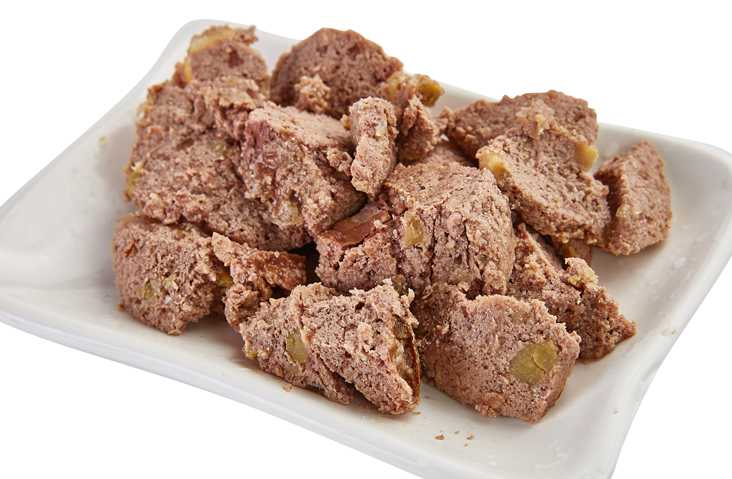Pet canned products are made from meat and by-products of livestock and poultry, with added supplementary ingredients, processed through steps such as mixing, emulsifying, canning, sterilizing, among others to form pet food.
This article introduces the production and processing flow of two types of pet canned foods: tinplate-packaged pet cans and soft-packaged pet cans.
Tinplate-packaged pet canned food is mainly produced by combining various sets of equipment; frozen livestock and poultry meat and by-products are coarsely minced after cutting, then mixed and emulsified with added ingredients, vacuum-mixed, metal detected, canned, sealed, sterilized, insulated, and packaged, completing the final product processing.
2. Description of the Tinplate-Packaged Pet Canned Process Flow
(1) Raw and Supplementary Material Inspection Process
Raw and supplementary materials are inspected according to legal regulations and company-specific inspection standards. After passing inspection, they are stored in the warehouse.
(2) Raw Material Storage Process
Raw and supplementary materials are stored in different warehouses according to the product characteristics. Generally, livestock and poultry meat raw materials are stored in cold storage below -18°C; other supplementary materials and packaging materials are stored at room temperature.
(3) Cutting and Coarse Grinding Process
After the raw materials are taken out from the warehouse and the raw material packaging is removed, they are detected by a metal detector and then transported by conveyor belt to the frozen meat cutting machine, which cuts large frozen pieces into smaller chunks for coarse grinding. The cut raw materials are then coarsely ground into meat paste using a meat grinder, which is then moved to the next processing step.
(4) Mixing Process
The coarsely ground meat paste is mixed with other supplementary materials (such as grains, vegetables, vitamins, and minerals) according to the formula proportion. During the mixing process, ensure that all raw materials are evenly distributed to guarantee the final product's quality and nutritional balance.
(5) Emulsification Process
The mixed raw materials are emulsified using an emulsifier, making the meat paste and supplementary materials finer and more evenly distributed, forming a stable emulsified state. This step helps to improve the texture and taste of the product.
(6) Vacuum Mixing Process
The emulsified raw materials are mixed under vacuum conditions to remove air bubbles, preventing issues caused by bubbles during subsequent canning and sterilizing processes.
(7) Metal Detection Process
The vacuum-mixed raw materials are detected by a metal detector again to ensure no metal impurities have been mixed in, safeguarding the product's safety.
(8) Canning Process
The metal-detected raw materials are canned into tinplate cans using a canning machine. The filling amount must be strictly controlled to ensure each can's weight and composition are consistent.
(9) Sealing Process
The canned tinplate cans are sealed using a sealing machine, ensuring that the can opening is tightly sealed to prevent external contaminants from entering the can.
(10) Sterilization Process
The sealed cans are sterilized using a high-temperature, high-pressure sterilization pot. Sterilization conditions are adjusted according to the product characteristics and can size to ensure the microbial safety of the products.
(11) Insulation Process
After sterilization, the cans are slowly cooled in an insulation room to prevent deformation or cracking due to sudden cooling.
(12) Packaging Process
The cooled cans are inspected for appearance; qualified products are labeled and packaged and then stored for sale.

The processing technique for soft-packaged pet cans is similar to that of tinplate cans but differs in the packaging and sterilization processes.
Soft-Packaged Pet Canned Process Flow Description
(1) Raw and Supplementary Material Inspection Process
Similar to tinplate cans, raw and supplementary materials need to go through strict inspection and storage.
(2) Cutting and Coarse Grinding Process
Similar to tinplate cans, raw materials need to go through cutting and coarse grinding processes.
(3) Mixing Process
Similar to tinplate cans, the coarsely ground meat paste is mixed with supplementary materials.
(4) Emulsification Process
Similar to tinplate cans, the mixed raw materials need to be emulsified.
(5) Vacuum Mixing Process
Similar to tinplate cans, the emulsified raw materials need to be mixed under vacuum conditions.
(6) Metal Detection Process
Similar to tinplate cans, the raw materials need to be detected by a metal detector.
(7) Canning Process
Unlike tinplate cans, the raw materials for soft pack cans are filled into soft packaging bags using a canning machine, with the filling amount strictly controlled.
(8) Sealing Process
The filled soft packaging bags are sealed using a heat sealing machine, ensuring tight sealing of the bag opening.
(9) Sterilization Process
The sealed soft packaging bags are sterilized using a high-temperature, high-pressure sterilization pot. Sterilization conditions are adjusted according to the product characteristics and bag size.
(10) Insulation Process
After sterilization, the soft packaging bags are slowly cooled in the insulation room to prevent the bags from breaking due to sudden cooling.
(11) Packaging Process
The cooled soft packaging bags are inspected for appearance; qualified products are labeled and packaged and then stored for sale.
Through the above processes, both tinplate-packaged and soft-packaged pet cans can ensure product quality and safety, meeting the nutritional needs of pets.